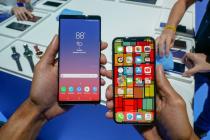Ever since the announcement of the Mi 5X, I really wanted to try this phone. It's no secret that I am fighting an implacable battle with DSLRs, and I think. However, Xiaomi products, and indeed all Chinese, have not yet reached the level of flagship cameras in terms of cameras. I really like OnePlus 3T (), and Xiaomi Mi5S, but, of course, compared to the Samsung Galaxy S8 +, they really shoot much worse. We were immediately promised "something really". However, first things first.
First, let's go through the technical specifications. There really is something to see here.
Front camera 5 MPix
| Xiaomi Mi 5X | |
| 5.5 '', 1080x1920, LTPS IPS LCD, Gorilla Glass 3 | |
Platform | Qualcomm MSM8953 Snapdragon 625 |
CPU | Octa-core 2.0 GHz Cortex-A53 |
Graphics Accelerator | |
RAM | 4 GB |
Internal storage | |
MicroSD support | Yes, instead of one of the SIM |
Main camera | Dual 12 MPix (26mm, f / 2.2; 50mm, f / 2.6), phase detection autofocus, dual-LED (dual tone) flash, 1.25 µm / 1.0 µm pixel size. Shooting video in 4K |
Front-camera | 5MP, 1080P video shooting |
Supported network interfaces | Wi-Fi 802.11 a / b / g / n / ac, Bluetooth: v4.2, A2DP, LE |
Navigation | GPS, A-GPS, GLONASS, BDS |
Communication and supported frequencies | Dual slot for nanoSIM 2G: GSM 850/900/1800 / 1900MHz CDMA BC0 / CDMA EVDO BC0 |
| Accelerometer, illumination, electronic compass, gyroscope, hall sensor, proximity | |
| USB Type-C | |
Battery | Non-removable Li-Ion 3080 mAh |
| 155.4 x 75.8 x 7.3 mm | |
| 165 g | |
First of all, it should be noted the presence of a dual 12-megapixel camera (wide-angle and telephoto module) - exactly the same as that installed in the flagship Xiaomi Mi 6, so video at least in 1080p, at least in 4K can be recorded without problems.
Most of the front panel is occupied by a 5.5-inch LTPS display with Full HD resolution (403 ppi, 450 nits), 2.5D glass with curved edges, below are the control buttons.

Most TFT arrays use amorphous silicon, but here an LTPS-TFT array is installed. The main advantages of the new technology are the reduction in power consumption and the size of transistors, which allows achieving high pixel densities (over 500 ppi). One of the first smartphones with IPS-display and LTPS-TFT matrix was OnePlus One. The colors are good, the display is bright, although not amoled.

The control buttons are completely touch-sensitive, no mechanics or even indentations.

At the back, the smartphone resembles the iPhone 7 Plus and OnePlus 5. This feeling is created by the equally located main cameras, antenna strips and slightly rounded edges of the case. In the pink color, in which I found my smartphone, it looks great, and you can't say that it belongs to the middle price segment.

The back panel of the device is made of brushed aluminum and does not collect fingerprints. There is a fingerprint scanner on it. The sensor works very quickly without any problems.

In my opinion, the scanner is located a bit high. If you have short fingers, it will not be very easy to reach it. But, on the whole, the device fits comfortably in the hand, does not "cut" into the palm and does not strive to slip out of it during use.
The on / off button and volume rocker are on the right.

On the left is only a slot for SIM cards and microSD.

Combined slot - either two SIM cards, or SIM + microSD.

Above, you can see the noise canceling connector and infrared port.

Below is a USB Type-C connector, a 3.5 mm headphone jack, another microphone, and a monaural speaker.

The package is minimalistic, nothing more. It is correct.

The box is white, but the logo on it is bright - apparently, the company decided that it needed to show its identity more :)
 | Xiaomi Mi 5 X box, back view |
 | Xiaomi Mi 5X box, front view |
All in all - the smartphone looks really cool, very well assembled, neat, thin, without any problems. Of course, someone can find fault with the rear location of the sensor, but it's not so scary.
Performance and hardware platform
The hardware platform Xiaomi Mi 5X is built on the Qualcomm Snapdragon 625 SoC, made using 14-nanometer technology. This SoC includes eight 64-bit ARM Cortex-A53 cores with a frequency of up to 2.0 GHz, the Adreno 506 video accelerator with a core frequency of up to 650 MHz is responsible for graphics processing. The amount of RAM is 4 GB, and the built-in flash memory is 32 or 64 GB, depending on the modification.
Interestingly, the 3DMark Sling Shot test on the smartphone did not start - apparently, this is a feature of the firmware that was used.
Qualcomm Snapdragon 625 is a platform designed for mid-range smartphones. This is no longer the most interesting chip in its category, it was replaced by the Snapdragon 626 with a higher core frequency (2.2 GHz instead of 2.0 GHz). Thanks to the 14 nm process technology, the SoC combines good performance with low power consumption. It should be noted that the novelty did not become more powerful than its predecessor Mi Max, although the public expected the use of at least Snapdragon 660 in Mi Max 2.
In both complex and graphics tests, the Snapdragon 625 SoC demonstrates satisfactory results for most tasks, at about 60K in AnTuTu. The performance is sufficient for recording and playing video up to 4K UHD resolution and for demanding games. Mortal Kombat X runs smoothly on your smartphone.
When tested in complex benchmarks, the performance turned out to be at the level of Xiaomi Mi Max 2 - however, the devices have the same hardware platform, so nothing unexpected.
Testing the graphics subsystem in game tests 3DMark, GFXBenchmark and Bonsai Benchmark:
| Xiaomi Mi Max 2 (Qualcomm Snapdragon 625) | Xiaomi Mi 5X
| Moto Z2 Play (Qualcomm Snapdragon 626) | HTC One X10 (MediaTek Helio P10) | Honor 6X (HiSilicon Kirin 655) | Moto E4 Plus (MediaTek (MT6737) |
|
| 3DMark Ice Storm Sling Shot ES 3.1 (more is better) | 464 | 458 | 470 | 421 | 378 | 99 |
| GFXBenchmark Manhattan ES 3.1 (Onscreen, fps) | 6 | 6 | 7 | 5 | 5 | 3 |
| GFXBenchmark Manhattan ES 3.1 (1080p Offscreen, fps) | 6 | 6 | 6 | 5 | 5 | 1 |
| GFXBenchmark T-Rex (Onscreen, fps) | 18 | 17 | 23 | 17 | 19 | 11 |
| GFXBenchmark T-Rex (1080p Offscreen, fps) | 23 | 23 | 23 | 17 | 19 | 6 |
Browser cross-platform tests (in Google Chrome):
As can be seen from the test results, the Xiaomi Mi 5X smartphone matches the performance of the Xiaomi Mi Max 2, only slightly lagging behind it. The lag can be explained by the compact body, and the stronger heating.
Camera
We are getting to the most important thing - testing the camera. As I said above, it is fully consistent. Identical sensors, software, post-processing. In fact, if you only need a camera from Mi6, and, at the same time, so that everything else is also on the same level, then this phone is in front of you.
The main feature here is of course the portrait mode, when a 50 mm camera is used for the main photo, and the second, wide-angle one, creates bokeh.
In bright light, portraits are very pleasing, with beautiful blur and pastel colors. Unfortunately, when bundled with portrait mode, we get always-on blurring of skin imperfections, however, unlike cheap Chinese devices, this mode does not turn men into transvestites.
The usual mode is also not bad, but here, it seems to me, the Korean flagships shoot better.

Here, the color rendition is sometimes not very successful, for some reason often with a departure in cold shades.

The front camera is conventional.

In total, the portrait mode is really cool, but the rest of the camera is pretty ordinary, it does not reach the Korean flagships.
Other nuances of use
The speaker of the smartphone is loud enough, moreover, when playing music, you can actually hear stereo (the earpiece is used as the second one). There is no bass, but overall the sound quality is good.
The speaker is excellent, loud and clear. Through the use of two microphones (one normal, one for noise canceling), the voice is transmitted very well.
The infrared port is useful for reducing the sound level in bars. Well, or in case you have lost your TV remote control somewhere.
The device does not have NFC.
Wireless charging is not supported.
I had a Chinese version without a "market" in my hands, but the craftsmen had already ported Android One to Mi5X, which they put on the Xiaomi Mi A1.
Autonomous work at the level - about 1.5 days. Mi Mix 2 works about the same time. In general, there is no need to constantly run with charge.
Satellites are caught perfectly, ten-finger multitouch.
Prices
Total
Anyone who wanted a camera from Xiaomi Mi6, but is not ready to pay a lot of money, and at the same time wants a high-quality smart one. There will be another option immediately with a pure android (Xiaomi Mi A1), but the craftsmen have already moved the firmware from it to the "Chinese".














